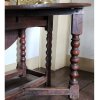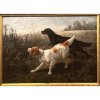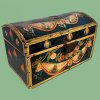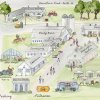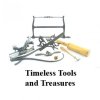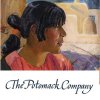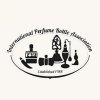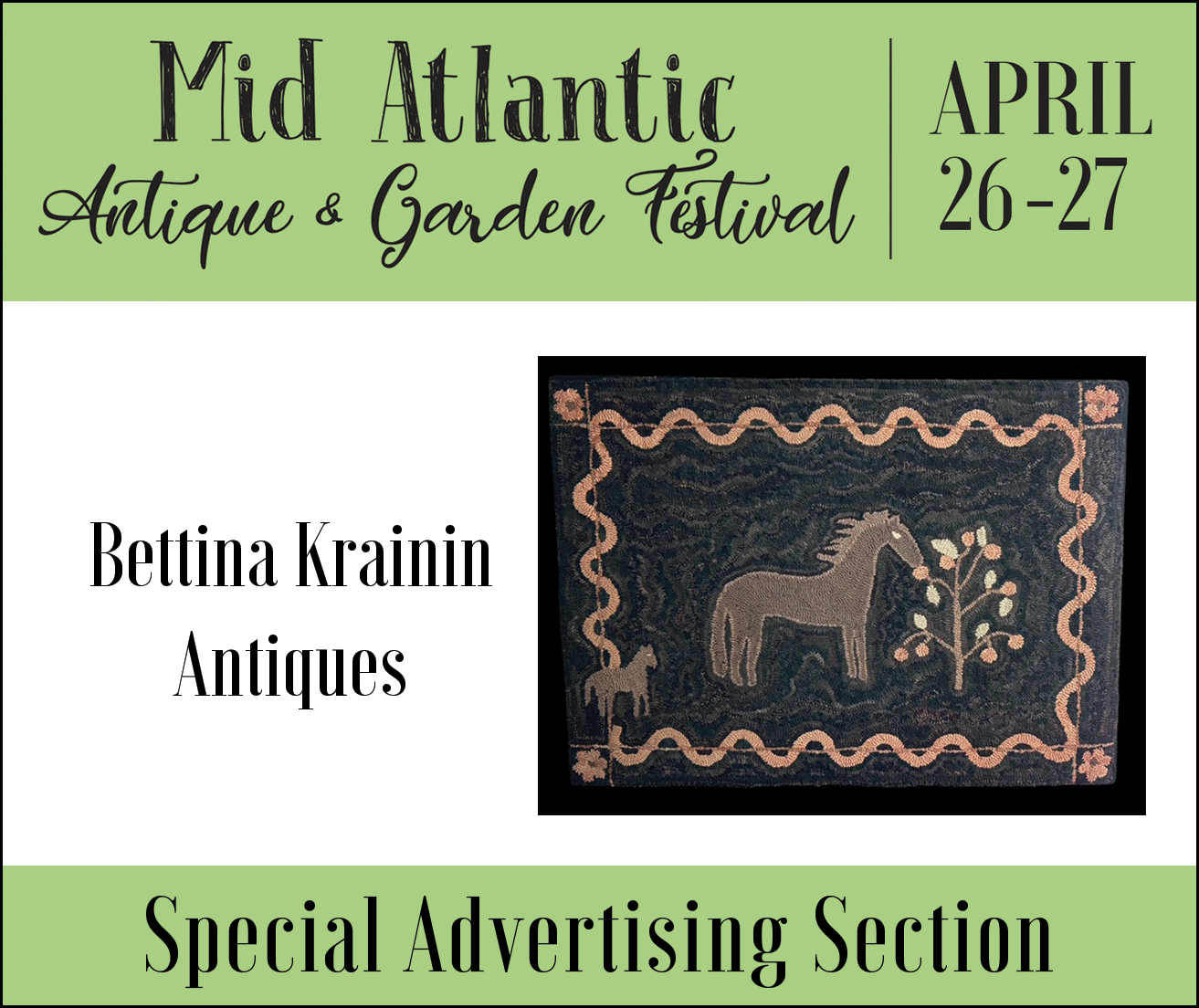Lebanon, Tennessee
The Heart of Tennessee Antique Show was held in Lebanon, Tennessee, February 13-15. The event featured 33 dealers and began with a Thursday evening preview party. The ninth annual show was once again part of Nashville’s antiques week, which offered five solid but distinct shows divvied up between Nashville and Lebanon, cities roughly 40 minutes apart.
What promoter Katherine Bovard has done during the nearly decade-long run of Heart of Tennessee is put together a group of dealers who stand out for the quality antiques they offer—merchandise palpably better than what’s at the average show. Any event can have a first-rate dealer with great merch. Heart of Tennessee has a venue full of them.
There remained something different about this show, something special. It began on opening day, with a preview party that was true to both the “preview” aspect and the “party” atmosphere. Showgoers paid $35 to attend the four-hour affair, compared to the $10 admission the following two days. The evening offered more than just a chance at getting first dibs on the goods. Jeffrey Evans delivered a preshow lecture on southern pottery ($50, including admission to the preview), and then Heart of Tennessee’s doors were flung open to a hall decorated with cast-iron urns filled with flowers and a long row of tables covered in white linen and fancifully arrayed with finger foods and desserts. The cash bar didn’t hurt, either.
Located at the center of the show, the miniature buffet served as a social area, where people with a passion for the industry—collectors, dealers, auctioneers—shared time with one another, a reminder that the trade is more than just sought-after objects. The food was catered. The floral arrangements were created by dealer Bruce Rigsby. It was all designed to impress.
And then there was the show itself.
![“That’s the best piece on the floor,” declared a customer about this Tennessee linen press, which features a stepped top with a peaked backsplash and open cubby flanked by two drawers and a base with four pairs of aligned drawers over turned legs. In walnut and having pegged construction, the linen press features a penciled inscription inside the lower-right drawer, “Maid [sic] March 1881 by Josiah Brown.” The upper-left drawer is inscribed “Lillie got this chist [sic] of drawers June 5, 1963.” Measuring 78](/uploads/visual_edit/hot0525-15.jpg)
“That’s the best piece on the floor,” declared a customer about this Tennessee linen press, which features a stepped top with a peaked backsplash and open cubby flanked by two drawers and a base with four pairs of aligned drawers over turned legs. In walnut and having pegged construction, the linen press features a penciled inscription inside the lower-right drawer, “Maid [sic] March 1881 by Josiah Brown.” The upper-left drawer is inscribed “Lillie got this chist [sic] of drawers June 5, 1963.” Measuring 78" high x 66" wide x 18" deep, it was priced at $8500 by Mark Hulse of Lebanon, Tennessee.
“Our show stands out against the others,” said Bovard. The quality made a difference. There was a nod toward formal furniture and accessories but also a strong representation of Americana and country antiques. The diversity included a Tennessee linen press that one customer described as “the best piece on the floor.” Made of walnut, the press featured a stepped top with peaked backsplash and an open cubby flanked by two drawers. The base had four pairs of aligned drawers over turned legs. Measuring 78" high x 66" wide x 18" deep, it was priced at $8500 by Mark Hulse of Lebanon, Tennessee.
A percussion pistol made in 1868 by gunsmith Theodore Willerding (1839-1889) of Evansville, Indiana, marked and dated, was priced at $4200 by Zac Ziebarth of Avoca, Wisconsin. The weapon is pictured in the book Indiana Gunmakers and Their Muzzle-Loading Long Rifles 1778-1900 by Jeffrey J. Jaeger, a copy of which accompanied the gun. “You don’t have local gunmakers making pistols like this,” said Ziebarth. “An identified Midwest pistol is quite rare. It’s the only one I’ve ever seen.”


Titled Memories on the frame, the exhibition-size oil on canvas painting by George Melville Smith (1879-1979) depicts a man resting and a young boy fishing. Signed and dated 1946 and with the frame painted to resemble paper birch, the work measures 35" x 47¼" (sight size) and came from a midwestern collection. It was priced at $4800 by Zac Ziebarth of Avoca, Wisconsin. Smith was a New Deal-era painter who created post office murals in Crown Point, Indiana, and in Elmhurst and Park Ridge, Illinois. Below the artwork were an identified Indiana percussion pistol with a ramrod, made by Theodore Willerding (1839-1889), stamped “Willerding Evansville Ind 1868,” with a checkered tiger maple grip, the octagonal barrel with remnants of bluing, tagged $4200; and a 1960s petit point squash blossom necklace, turquoise and silver, $3900. The pistol is pictured in the book Indiana Gunmakers and Their Muzzle-Loading Long Rifles 1778-1900 by Jeffrey J. Jaeger, a copy of which accompanied the gun.

Bill and Joyce (d. 2020) Subjack of Neverbird Antiques, Surry, Virginia, once had a goal of collecting a sampler from every state. Over the years, their collection had examples from 44 states. This sampler from Marshall County, Tennessee, was wrought by Martha Ann Bruce and dated 1841. Measuring 18½" x 18½" (sight size), it was priced at $8800 by Neverbird Antiques.
Rarity was also in store at the booth of Neverbird Antiques, Surry, Virginia, which featured samplers from identified locations in Alabama, Illinois, Indiana, Missouri, North Carolina, Tennessee, and Virginia. An example from Marshall County, Tennessee, wrought by Martha Ann Bruce and dated 1841, measuring 18½" square, was tagged $8800. Ephemera in the booth included early newspapers and a wide assortment of historical documents. Of particular interest was a Revolutionary War-era letter written in 1781 by 14-year-old Lelia Skipwith (1767-1837) to her father, penned just days before the British defeat at Yorktown and mentioning her being at an event with George Washington, French military officer Rochambeau, and French statesman and diplomat Charles Gravier.

Southern furniture offered by Jim Hewitt of James Hewitt Antiques, Woodstock, Georgia, included an Alabama server in pine, priced at $3595. Measuring 36" high x 32" wide x 23" deep, it had been passed down through the family of L. D. Miller of Lineville, Alabama, whose father made the server. After Miller sold the piece, it ended up in south Florida, where it recently survived a hurricane after the owner moved it off the floor before the storm surge. On top of the server was stoneware from the Edgefield District in South Carolina: a straight-sided jar, priced at $750; an ovoid double-handled jug marked for John W. Seigler & Co. pottery of Pine House, South Carolina, said to be one of only two handled jugs by the maker known, $12,000; and a single-handled pot, possibly from the Landrum family, with a tight crack, $1250. Beneath the server were two pieces of cobalt-decorated salt-glazed stoneware: a Baltimore three-gallon jar attributed to Thomas Morgan, $1695; and a three-gallon jar by the Parr family of Baltimore, $795. The firkins were $165 to $325 each.

Lynn Bogue Hunt (1878-1960), one of the most important sporting artists of the 20th century, is largely remembered for his outdoor scenes of wildlife and game birds. Considered the most famous of Field & Stream’s illustrators, he painted multiple covers a year for the magazine from 1924 to 1947, with his final cover for the periodical released in 1951. Hunt’s obituary in The New York Times referred to him as “the Audubon of his time.” This oil on canvas painting by Hunt, depicting an English springer spaniel flushing a pheasant, was used as the cover for Field & Stream in November 1927. Measuring 27½" x 21½" (sight size), the painting was tagged $58,000 by Robert Burger. After publication, the image was used for calendars and prints, as well as for outdoor advertising that included mirrors and thermometers.

Kevin Ross of Ross & Co. Antiques, Chillicothe, Ohio, had the most diverse offerings on the floor, ranging from a three-dimensional violin trade sign made of metal to a Black Forest hall tree featuring mountain goats to floor-standing harps. “We have everything from Fabergé to Americana,” said Ross. Oddities included a cigar-store figure of a muscular Samson with a raised sword, advertising “Samson Segars Snuff,” one side lettered “Fine Tobacco / Importers / Delos & Larke / E. Liverpool, O.,” the opposite side with a tobacco leaf. It stands 67" high and was priced at $55,000. “There’s never been another one known to exist,” said Ross. At one time the figure was displayed at the original location of The Spaghetti Warehouse in Columbus, Ohio, he added.
There was an Alabama server marked $3595 by James Hewitt Antiques of Woodstock, Georgia; an oil painting of a hunting scene by Lynn Bogue Hunt (1878-1960), depicting an English springer spaniel flushing a pheasant, priced at $58,000 by Robert Burger of Mount Vernon, Ohio; and a cigar-store figure of a warrior, promoting “Samson Segars Snuff,” offered at $55,000 by Kevin Ross of Ross & Co. Antiques, Chillicothe, Ohio. The good stuff didn’t stop. The show was solid—front to back, side to side.
Bovard succeeded in piecing together the event she envisioned when Heart of Tennessee was conceived. One of the hardest working promoters in the antiques industry, she’s found the right dealers. She’s ecstatic about the building, the Farm Bureau Exposition Center. And she’s happy with the 30-some-dealer size of the show. Although there’s plenty of room to grow, Bovard has no plans for exponential increases. “The way the industry is going, I think the smaller, the better,” she said.
“I’ve been very proud of our show. We’ve had success. The customers have been very loyal. It’s been fantastic.”
Those customers have been instrumental in keeping Heart of Tennessee in Lebanon. Over the years, Bovard has asked her shoppers if she should move the show to Nashville, where The Nashville Show and Fiddlers Antique Show have firmly established a home at The Fairgrounds Nashville. Heart of Tennessee shoppers were clear. “They said, ‘No,’” Bovard stated. And she’s pleased to stay put. “Our shows stand out. We would not look as good in the building in the [Nashville] fairgrounds as in our building now.”
“It’s a beautiful show,” she added. “Easy. Laid back. We’ve not had any problems.... I love my show.”
For more information on Heart of Tennessee, phone Bovard at (330) 631-1604 or visit the website (www.heartoftennesseeantiqueshow.com).

R. Stephen Johns of Grosbeak Antiques, Bloomington, Indiana, is best known for his Native American baskets, but fitting in well with his display was this oil on canvas portrait of a prize bovine, signed “Harris.” Circa 1890 and measuring 19" x 23¼" (sight size), it was priced at $3400.

Cattle dominated one corner of the booth of Bettina Krainin of Bethlehem, Connecticut. The folky hooked rug with a central bovine and bee skeps in the corners, mounted, 36½" x 41", was $2600, while the weathervane, 15½" high x 20½" wide (excluding base), was $2800. The early 19th-century wall box in red paint was $750; the double wall baskets in brown paint were $950; and the small blanket chest on bootjack feet, having carved diamonds and inscribed “F F / 1707,” 23" high x 36" wide, was $4200.

Mary de Buhr of Downers Grove, Illinois, is known for her wooden primitives. From left are a hornbeam and masher (partially obscured), sold during the show; a tall, heavy shaved broom, 1800-20, 52" long, $2150; a smaller shaved broom, $1075; a mortar and pestle from a historical museum in New Hampshire, circa 1700, $1095; an 18th-century shaved broom with a braided head, 50" long, $1750; a Native American burl mortar, New England, early 18th century, 15" high x 18" diameter, $1250; and three shaved brooms (hanging, partially visible), $1350 to $1800 each.

Michael Whittemore of Michael Whittemore Antiques & Folk Art, Punta Gorda, Florida, offered a scrub-top sawbuck table, the base in blue paint, 27½" high x 39½" wide x 28" deep, at $1650; and a copper weathervane in the shape of a prancing horse with a rider, 30" high x 27½" wide, priced at $19,500.


These unsigned folk paintings are said to bear “the unmistakable characteristics of a significant itinerant portrait painter.” Never restored and in their original gilt frames, they were priced at $14,500 the pair from James and Joanne Lowery of James Wm. Lowery Fine Antiques & Arts, Baldwinsville, New York.

In brown paint and dating to the 18th century, this hanging cupboard has a lower set of clothes pegs and a shelved interior with two lower drawers. It is dovetailed and has rosehead nails. Measuring 40" high x 27" wide, the cupboard was marked $1200 by Barbara Veazey of BV Antiques & Fiber Art, Paducah, Kentucky.

Great blue paint? Check. Nice small size? Check. This 15-drawer apothecary has the basics covered. With square-nail construction and rabbet-joint drawers, it dates to about 1850 and is 19¾" high x 17½" wide x 8" deep. The apothecary was tagged $2650 by Cathy Consentino of Timber River Farm Country Antiques, New Brunswick, Canada.

Want folky to the nth degree? There was this metal horse. Broad body. Elongated neck. Short legs. Standing 33½" high x 32" wide, it was priced at $3600. The Doris Stauble arrangement has size in its favor; the rectangular basket was offered at $995. The dry sink in oyster paint is special too. On the top, it has a divided side compartment. Inside is a single shelf with a beveled front edge. Measuring 32" high x 35½" wide x 19" deep, it was tagged $6200 by Hannah Humes of Alexandria, Ohio.

When Betty Bell is in the house, fantastic holiday antiques can’t be too far away. This German clockwork reindeer with a loofah sleigh, Santa, and period toys, 13" high x 27" long, was $13,950 from Betty and Folsom Bell of Betty Bell Antiques, Dallas, Texas.

In November 1889 the United States admitted North and South Dakota, Washington, and Montana into the Union, bringing the total number of states to 42. To celebrate, manufacturers began producing 42-star flags, even though the new star count wasn’t due to go into effect until July 4, 1890, when the federal government would formally recognize the change to the flag. When Idaho sneaked in as the 43rd state on July 3, 1890, it rendered the 42-star flag obsolete before it had even reached “official” status. This framed 42-star flag, measuring 18½" x 25" (flag only), was priced at $850 by Judson and Karen Fults of Signature Antiques N Art, Lakeview, Ohio. The percussion rifle with a ramrod and octagonal barrel, the lock marked “Steele & Warren, Albany,” 1830s, 50" long, was $1650.

A late cancellation allowed Mark and Keely Richardson of Big Lick Antiques to take an extra booth. They filled the space with advertising signs and petroliana—a different look for the show. The Firestone single-sided porcelain-over-steel sign, 23½" x 71", was $2750; the Fisk porcelain-over-steel single-sided sign, 18½" x 62", $3450; the Macmillan Oil double-sided sign, painted metal, 30" x 29", $695; and the hanging Wall’s Ice Cream sign, double-sided, 18½" x 30", was $925.
Originally published in the May 2025 issue of Maine Antique Digest. © 2025 Maine Antique Digest












